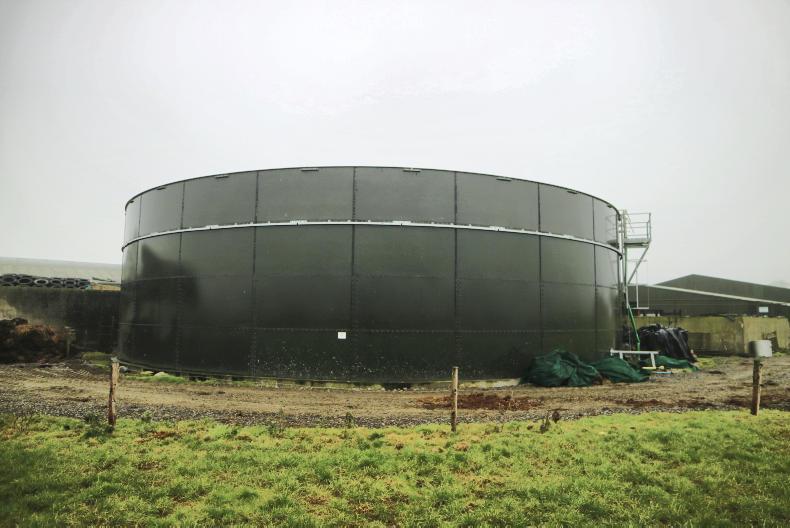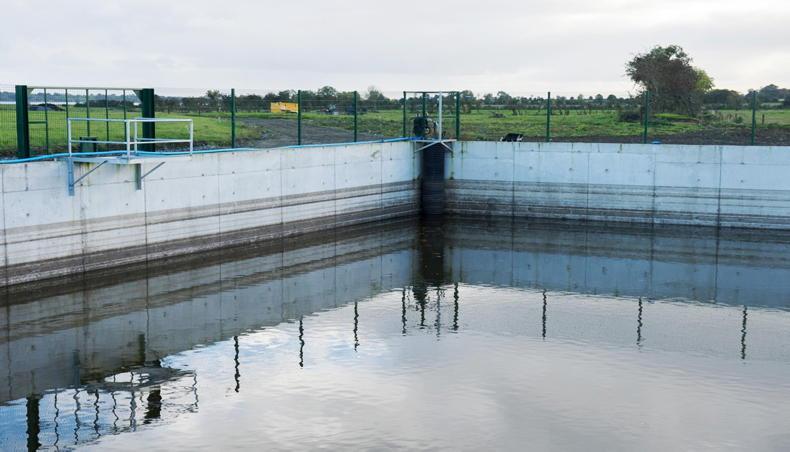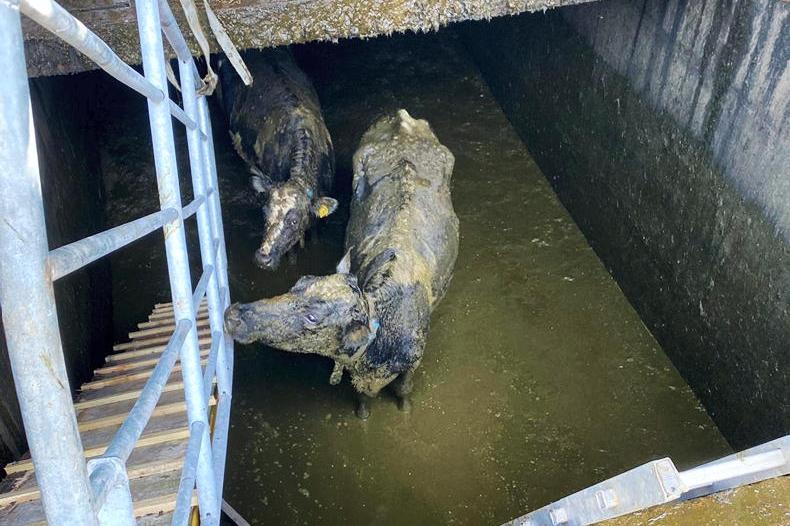Farmers are required by law to have sufficient slurry storage capacity for the number of livestock they have on their farm. Slatted tanks, overground slurry stores and lagoons, are the three most popular storage options, but there can be a large difference in the associated costs of each option. Generally, slatted tanks will be the most expensive. However, they do have the added benefit of providing scope for additional housing facilities, so it really depends on each farmer’s circumstances.
Planning permission, or an exemption from planning, will be required no matter which option you choose. It can take up to three months to get planning permission approval and if you need additional storage for the coming winter this application should be made in the coming weeks.
However, as we are already into June, time is against you if you want to use the Targeted Agricultural Modernisation Scheme (TAMS) to help finance this investment, as it could take a further three months to get TAMS approval. It is not possible to get TAMS approval without first having full planning permission.
One option available to farmers is to install the slatted tank once planning permission is granted.

While this is happening, they can make the TAMS application for the shed which they would still be eligible for grant aid on. This ensures they have sufficient storage for the coming winter.
However, you need to get a certified engineer to sign off that the tank has been built to specification. This requires the engineer to be involved the whole way through the project to verify the correct steel and concrete has been used.
A word of caution: some farmers have encountered issues where the engineer who inspects the tank is not certified. In this instance, grant aid cannot be paid on the portion of the shed over the tank.
Overground storage tanks
When it comes to circular overground slurry storage tanks, farmers can choose anything from 100,000 gallons up to 1,000,000 gallons. One of the most popular options is the 300,000 gallon tank.
As a rough guide, it is recommended to have at least two weeks’ storage in the reception tank
This storage solution has many advantages and can be ideal for increasing storage capacity on an existing farm, with very little construction work. They can also be installed very quickly and there are no major groundworks required.
However, there are some disadvantages to the system. Slurry will generally have to be pumped from a reception tank to the overground tank. These pumps can cost approximately €4,000 excluding VAT.
The time taken to pump slurry and the costs involved must also be taken into account. In many cases, farmers will allow the agitated slurry back into the reception tank to be spread.
As a rough guide, it is recommended to have at least two weeks’ storage in the reception tank. The pump can be up to 30m away from the overground tank and still work effectively. There can also be difficulties when it comes to agitating the tank, as a crust can form on top of the slurry. However, overall they can be a very cost-effective method of increasing storage capacity.
The conditions attached to the approval of planning permission can vary from county to county, but it is understood that the conditions are getting tighter in some counties, such as Limerick and Cork. In these two counties, it is required to have a bunded area around the tank as part of the development.
Another area of concern for some councils is in relation to the shut-off valve, mostly due to human error
It is also required to have clay all around it. Planners who have made planning applications in these counties say the bunded area is described as a raised earthen bank surrounding the tank.
This area would have to be capable of holding 110% of the storage of the tank, in case the tank burst or leaked. Another area of concern for some councils is in relation to the shut-off valve, mostly due to human error.
The main specifications when it comes to overground slurry stores can be found on the Department’s website under S122. Some of the main specifications include:
Hardcore must be laid and compacted in the area where the slurry store is to be erected. Hardcore must be compacted in 150mm layers using a vibrating or heavy roller. A 1,000-gauge polythene membrane must be laid on the finished hardcore with 600mm overlaps.Steel mesh must be laid on all floors.The concrete must be thoroughly compacted using a vibrating screed, and compaction around steel reinforcement must be carried out with a poker vibrator.All points for emptying the tank, through either the side or base, must be controlled by at least two valves in series.1 Calculating storage
requirements
When it comes to calculating slurry storage capacity, farmers will need 16, 18, 20 or 22 weeks of storage, depending where in the country they are located. It is always useful to factor in a couple of weeks’ storage as a buffer, to ensure the farm does not come under increased pressure during a wet spring.
According to nitrates regulations, a dairy cow will produce 0.33m3/week. If we calculate this over an 18-week period, it would equal 5.94m3 of slurry produced by a dairy cow over the winter period (see Table 1 for different storage periods).
For 100 cows, this would mean total production of 594m3.
However, when calculating the storage requirements you must also take into consideration the amount of rainwater that will fall into the open tank. A freeboard of 300mm is required to be left at the top of all uncovered tanks. This is excluding rainfall. Depending where in the country you are located, the amount of rainwater will vary, but as a rule of thumb approximately 30% of the tank will be taken up by the required free space and rainwater. This could be more in high-rainfall parts of the country.
If we look at the example above for our 100-cow herd, we would need to increase the storage from 594m3 up to 850m3 to take into account freeboard and rainwater.
Looking at Table 2, a 212,929 gallon tank would be the most suitable for this situation. It equates to 968m3. The total cost of such a development would be €35,000 plus VAT for the steel tank, while the base would cost approximately €8,000 plus VAT. This would leave total cost at €43,000 plus VAT.
The TAMS reference cost for such a circular slurry tank is calculated based on the capacity of the tank in m3, using the following equation: 23.5(Xm3) + 20,900. This would equate to a reference cost of 23.5(968m3) + 20,900 = €43,648 excluding VAT.
This tank would have a height of 4.27m and a diameter of 17.08m. This tank could be increased by adding a fourth ring to it.
This would bring capacity to 1,289m3 or 283,468 gallons. The cost of putting an additional ring on is approximately €12,000 plus VAT.
The 4.27m tanks in Table 1 have three rings, while the 5.67m tanks have four rings. Going with the three-ring tank gives you good scope to expand in the future if required as the herd grows. We also see with the bigger tanks how the cost/m3 of storage space decreases from €44 to €30.
Slatted tanks will continue to be the most common slurry storage option for farmers, as they will usually be constructed in conjunction with other on-farm developments, such as animal housing. Costs for slatted tanks will generally range between €95 and €105/m3 depending on the design.
Unlike circular stores, the cost of slatted tanks/m3 will not decrease, as the size of the tank increases. The freeboard required at the top of the tank will decrease from 300mm to 200mm, while rainwater will also not have to be accounted for.
If we take a slatted tank of 968m3, the same size as the circular option above, the requirement for freeboard decreases to approximately 8% of the total capacity of the tank, as opposed to 30% in an uncovered tank. Of the 30% in the uncovered tank, approximately 20% of this will be water (this varies depending where in the country you are located). This additional 20% is equivalent to 194m3 or 42,592 gallons of extra slurry that needs to be spread. Using a 3,000 gallon tanker and spreading an average of three tankers/hour it would take 4.6 hours to spread this extra 42,592 gallons. Using a guide of €85/hour for spreading, this gives an additional cost of €400 to spread this extra slurry.
Farmers are required by law to have sufficient slurry storage capacity for the number of livestock they have on their farm. Slatted tanks, overground slurry stores and lagoons, are the three most popular storage options, but there can be a large difference in the associated costs of each option. Generally, slatted tanks will be the most expensive. However, they do have the added benefit of providing scope for additional housing facilities, so it really depends on each farmer’s circumstances.
Planning permission, or an exemption from planning, will be required no matter which option you choose. It can take up to three months to get planning permission approval and if you need additional storage for the coming winter this application should be made in the coming weeks.
However, as we are already into June, time is against you if you want to use the Targeted Agricultural Modernisation Scheme (TAMS) to help finance this investment, as it could take a further three months to get TAMS approval. It is not possible to get TAMS approval without first having full planning permission.
One option available to farmers is to install the slatted tank once planning permission is granted.

While this is happening, they can make the TAMS application for the shed which they would still be eligible for grant aid on. This ensures they have sufficient storage for the coming winter.
However, you need to get a certified engineer to sign off that the tank has been built to specification. This requires the engineer to be involved the whole way through the project to verify the correct steel and concrete has been used.
A word of caution: some farmers have encountered issues where the engineer who inspects the tank is not certified. In this instance, grant aid cannot be paid on the portion of the shed over the tank.
Overground storage tanks
When it comes to circular overground slurry storage tanks, farmers can choose anything from 100,000 gallons up to 1,000,000 gallons. One of the most popular options is the 300,000 gallon tank.
As a rough guide, it is recommended to have at least two weeks’ storage in the reception tank
This storage solution has many advantages and can be ideal for increasing storage capacity on an existing farm, with very little construction work. They can also be installed very quickly and there are no major groundworks required.
However, there are some disadvantages to the system. Slurry will generally have to be pumped from a reception tank to the overground tank. These pumps can cost approximately €4,000 excluding VAT.
The time taken to pump slurry and the costs involved must also be taken into account. In many cases, farmers will allow the agitated slurry back into the reception tank to be spread.
As a rough guide, it is recommended to have at least two weeks’ storage in the reception tank. The pump can be up to 30m away from the overground tank and still work effectively. There can also be difficulties when it comes to agitating the tank, as a crust can form on top of the slurry. However, overall they can be a very cost-effective method of increasing storage capacity.
The conditions attached to the approval of planning permission can vary from county to county, but it is understood that the conditions are getting tighter in some counties, such as Limerick and Cork. In these two counties, it is required to have a bunded area around the tank as part of the development.
Another area of concern for some councils is in relation to the shut-off valve, mostly due to human error
It is also required to have clay all around it. Planners who have made planning applications in these counties say the bunded area is described as a raised earthen bank surrounding the tank.
This area would have to be capable of holding 110% of the storage of the tank, in case the tank burst or leaked. Another area of concern for some councils is in relation to the shut-off valve, mostly due to human error.
The main specifications when it comes to overground slurry stores can be found on the Department’s website under S122. Some of the main specifications include:
Hardcore must be laid and compacted in the area where the slurry store is to be erected. Hardcore must be compacted in 150mm layers using a vibrating or heavy roller. A 1,000-gauge polythene membrane must be laid on the finished hardcore with 600mm overlaps.Steel mesh must be laid on all floors.The concrete must be thoroughly compacted using a vibrating screed, and compaction around steel reinforcement must be carried out with a poker vibrator.All points for emptying the tank, through either the side or base, must be controlled by at least two valves in series.1 Calculating storage
requirements
When it comes to calculating slurry storage capacity, farmers will need 16, 18, 20 or 22 weeks of storage, depending where in the country they are located. It is always useful to factor in a couple of weeks’ storage as a buffer, to ensure the farm does not come under increased pressure during a wet spring.
According to nitrates regulations, a dairy cow will produce 0.33m3/week. If we calculate this over an 18-week period, it would equal 5.94m3 of slurry produced by a dairy cow over the winter period (see Table 1 for different storage periods).
For 100 cows, this would mean total production of 594m3.
However, when calculating the storage requirements you must also take into consideration the amount of rainwater that will fall into the open tank. A freeboard of 300mm is required to be left at the top of all uncovered tanks. This is excluding rainfall. Depending where in the country you are located, the amount of rainwater will vary, but as a rule of thumb approximately 30% of the tank will be taken up by the required free space and rainwater. This could be more in high-rainfall parts of the country.
If we look at the example above for our 100-cow herd, we would need to increase the storage from 594m3 up to 850m3 to take into account freeboard and rainwater.
Looking at Table 2, a 212,929 gallon tank would be the most suitable for this situation. It equates to 968m3. The total cost of such a development would be €35,000 plus VAT for the steel tank, while the base would cost approximately €8,000 plus VAT. This would leave total cost at €43,000 plus VAT.
The TAMS reference cost for such a circular slurry tank is calculated based on the capacity of the tank in m3, using the following equation: 23.5(Xm3) + 20,900. This would equate to a reference cost of 23.5(968m3) + 20,900 = €43,648 excluding VAT.
This tank would have a height of 4.27m and a diameter of 17.08m. This tank could be increased by adding a fourth ring to it.
This would bring capacity to 1,289m3 or 283,468 gallons. The cost of putting an additional ring on is approximately €12,000 plus VAT.
The 4.27m tanks in Table 1 have three rings, while the 5.67m tanks have four rings. Going with the three-ring tank gives you good scope to expand in the future if required as the herd grows. We also see with the bigger tanks how the cost/m3 of storage space decreases from €44 to €30.
Slatted tanks will continue to be the most common slurry storage option for farmers, as they will usually be constructed in conjunction with other on-farm developments, such as animal housing. Costs for slatted tanks will generally range between €95 and €105/m3 depending on the design.
Unlike circular stores, the cost of slatted tanks/m3 will not decrease, as the size of the tank increases. The freeboard required at the top of the tank will decrease from 300mm to 200mm, while rainwater will also not have to be accounted for.
If we take a slatted tank of 968m3, the same size as the circular option above, the requirement for freeboard decreases to approximately 8% of the total capacity of the tank, as opposed to 30% in an uncovered tank. Of the 30% in the uncovered tank, approximately 20% of this will be water (this varies depending where in the country you are located). This additional 20% is equivalent to 194m3 or 42,592 gallons of extra slurry that needs to be spread. Using a 3,000 gallon tanker and spreading an average of three tankers/hour it would take 4.6 hours to spread this extra 42,592 gallons. Using a guide of €85/hour for spreading, this gives an additional cost of €400 to spread this extra slurry.










SHARING OPTIONS